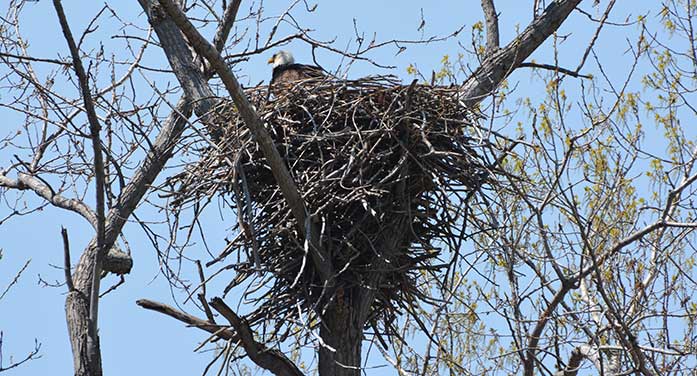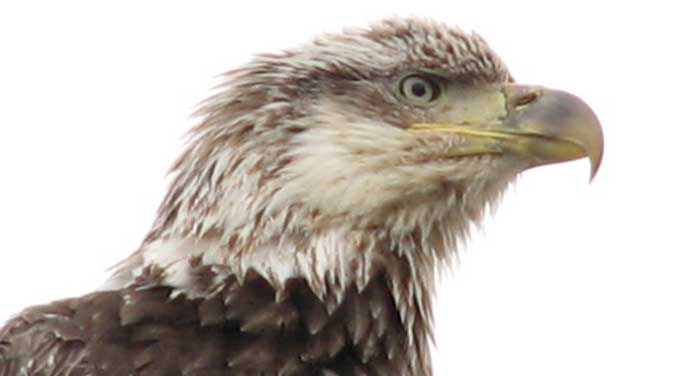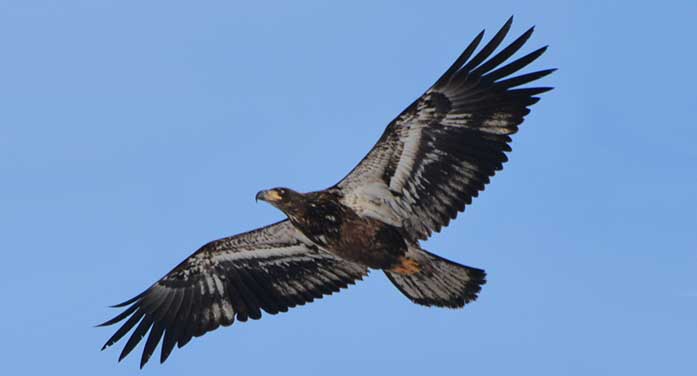
The bald eagle builds a huge stick nest that may be used over many years
 The majestic bald eagle never fails to arouse awe in observers fortunate enough to spot it.
The majestic bald eagle never fails to arouse awe in observers fortunate enough to spot it.
In the 19th and 20th centuries, it variously was considered common to rare in North America, depending primarily on where you lived. They historically nested in 45 of the 48 contiguous United States but have declined dramatically since.
One version was easily found along the coast of the southeastern states, but its northern counterpart was already scarce by the early 1900s. Then came the 1970s, when the bald eagle’s populations, like those of many raptors, were devastated due to exposure to DDT and similar pesticides. Rachael Carsen wrote of this in her classic book Silent Spring.
In Central Canada, the bald eagle has always been an uncommon migrant. It seems to have become a bit more common in the past few years; in 2017, there was a nesting northeast of Toronto and again east of Toronto in 2021. This is exciting since it seems the bald eagle has never been a regular breeder in this area.
On the West Coast of Canada, the bald eagle is more common and frequently found as a winter visitor and as a nesting species.
This great bird of prey is one of two species of eagles that arrive in Ontario as migrants in the fall. The other is the golden eagle, which nests in extreme northern Ontario and beyond, and migrates through southern Ontario in small numbers in mid-October and November.
The bald eagle builds a huge stick nest that may be used over many years. Each year the adults, which tend to mate for life, add a few sticks and make a few repairs. Over time, this may create a burden on the host tree, and it simply falls over or the top breaks off from the weight of the nest, which can weigh up to a tonne. Hopefully, the baby eaglets aren’t in the nest when this happens.
White pine is often their preferred nesting tree because they’re very tall. They also have massive trunks and supporting branches on which to build nests.

Identifying the adult bird is easy – they’re huge and have black bodies, with pure white heads and tails
Two or three eggs are laid and incubated for about 35 days. After 10 to 14 weeks, one or two of the young usually fledge, but rarely three. The mortality of first-year birds is very high: after that, their chances of surviving 25 to 30 years are quite good.
Their food consists primarily of fish, small mammals and carrion, but I’ve seen bald eagles take ducks off the water in winter. If they can’t catch fresh fish, you’re more likely to see them feasting on a washed-up carcass on the shore of a lake or ocean.
Identifying the adult bird is easy – they’re huge and have black bodies, with pure white heads and tails. The adult plumage is attained in the fourth or fifth year and carried for the rest of the bird’s life.
The young can be much more of a challenge to identify since they’re brown or mottled brown and white. Sometimes they look very much like an immature golden eagle, so careful study might be necessary to be sure what you saw.

Migration is interesting as most leave Ontario in the winter, although a few may stay if food is plentiful
This bird’s migration is interesting as most leave Ontario in the winter, although a few may stay if food is plentiful and there are significant roost trees nearby. According to the United States Fish and Wildlife Service’s Northern States Bald Eagle Recovery Plan, there’s a definite link between large, stable, undisturbed roost trees and wintering numbers. The service speculates that if these trees don’t exist in significant numbers, nesting likely won’t occur, and the large numbers of eagles that the West Coast is famous for won’t materialize.
Just keep your eyes open – you just might see this incredible bird and its young.
Geoff Carpentier is a published author, expedition guide and environmental consultant. Visit Geoff on LinkedIn, Instagram and Facebook. For interview requests, click here.
The opinions expressed by our columnists and contributors are theirs alone and do not inherently or expressly reflect the views of our publication.
© Troy Media
Troy Media is an editorial content provider to media outlets and its own hosted community news outlets across Canada.


